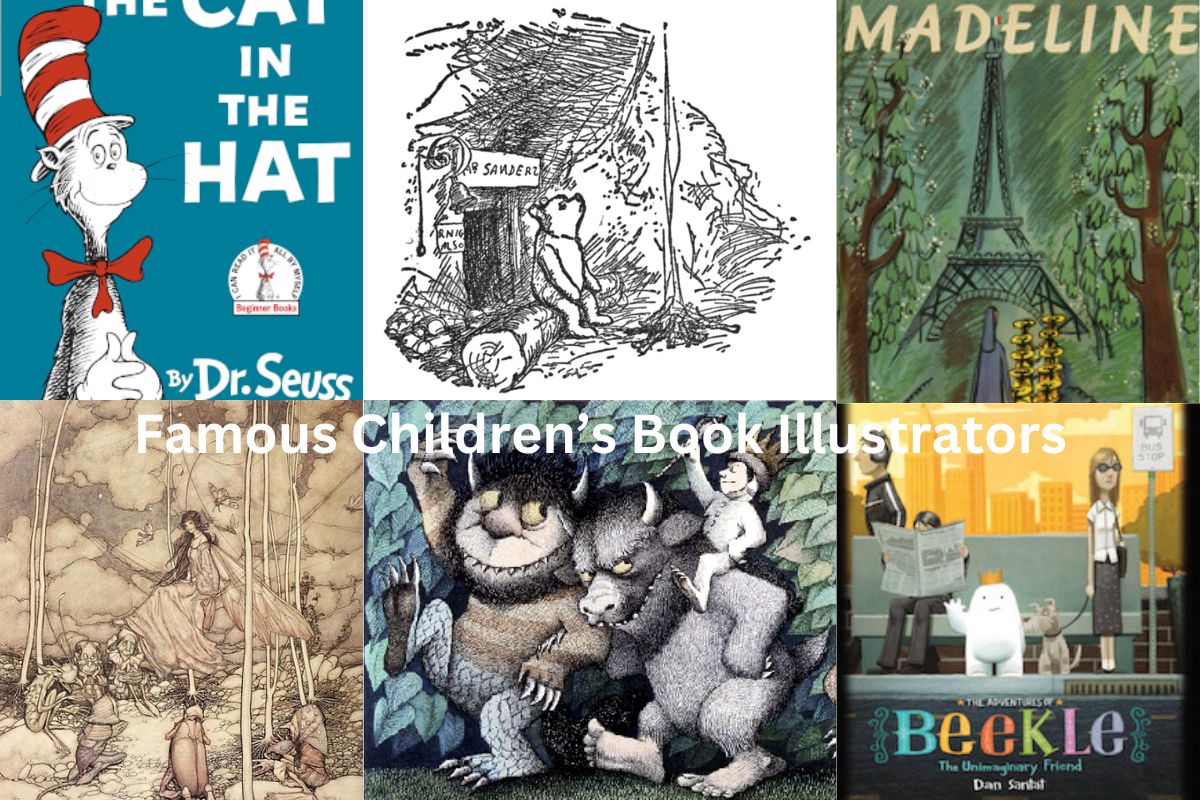Children’s book illustrators are artists that use beautiful and innovative images to bring stories to life. Graphics play an important role in the design of children’s books by bringing a visual dimension to the words on the page, attracting young readers’ interest and creativity.
Many well-known children’s book artists have become household names, renowned for their distinctive styles and endearing characters. From Dr. Seuss’ whimsical pictures to Beatrix Potter’s precise illustrations, these artists have made an unforgettable influence on the world of children’s books.
Their images have the ability to take children to other places, fire their imaginations, and encourage a lifelong love of reading. These famous illustrators‘ works have become timeless classics, inspiring generations of children and adults alike.
Famous Children’s Book Illustrators
1. Beatrix Potter
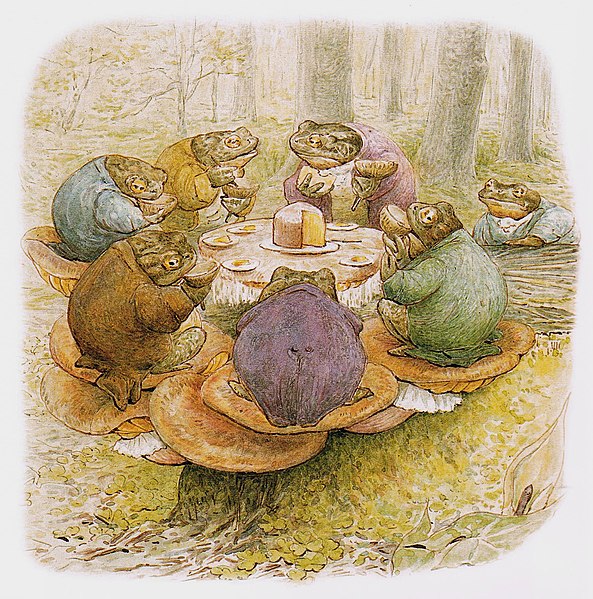
Beatrix Potter (1866-1943) was an English author, artist, and conservationist best known for her beloved children’s stories starring animal characters, such as “The Tale of Peter Rabbit.”
Potter was up in a wealthy family with a love of nature and the great outdoors. She was home-schooled and developed an early interest in art and natural history, sketching and painting creatures and insects she saw during family vacations in the countryside.
In the late 1890s, Potter began writing and painting a series of children’s books featuring animal characters, beginning with “The Tale of Peter Rabbit” (1902), which she originally wrote and painted as a message to her former governess’s children. The book was an instant success, and it went on to become one of the best-selling children’s books of all time.
Potter went on to write more than twenty more children’s books, including “The Story of Jemima Puddle-Duck,” “The Tale of Tom Kitten,” and “The Tale of Mrs. Tiggy-Winkle,” all of which featured her signature wacky animal characters and detailed illustrations.
In addition to her profession as an author and illustrator, Potter was an avid conservationist and landowner. She bought several farms in England’s Lake District and grew involved in farming and preserving the local landscape.
Beatrix Potter’s works continue to delight children and adults all over the world, and her legacy as a pioneering author, illustrator, and conservationist is appreciated.
2. Quentin Blake
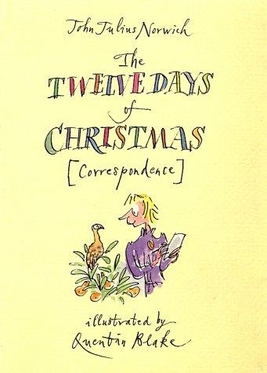
Quentin Blake (born 1932) is an English artist, illustrator, and novelist best known for his collaborations with author Roald Dahl, including the visuals for “The BFG,” “Matilda,” and “Charlie and the Chocolate Factory.”
Blake began working as a freelance artist in the 1950s after attending the Chelsea School of Art and the Royal College of Art in London. He has illustrated over 300 books, including “Clown” and “Mrs. Armitage on Wheels.”
Blake’s distinctive style is distinguished by sloppy lines, vibrant colors, and a sense of whimsy and comedy. He is well-known for his ability to capture the essence of a character or an event in a few short phrases, usually with comedy and wit.
Blake is an advocate for art education and has worked with many groups to promote the arts in schools, in addition to his work as an illustrator and author.
Quentin Blake is currently regarded as one of the most well-known and adored children’s book illustrators, and his images continue to inspire and thrill readers of all ages. His contributions to children’s literature have earned him numerous honors, including the Kate Greenaway Medal and the Hans Christian Andersen Award.
3. Dr. Seuss
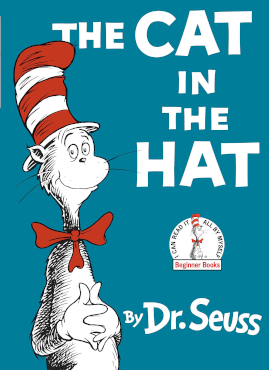
Theodor Seuss Geisel (1904-1991), commonly known as Dr. Seuss, was an American novelist, cartoonist, and illustrator best known for his children’s books.
Geisel began his career as a commercial cartoonist and artist for magazines and newspapers. He released his first children’s book, “And to Think I Saw It on Mulberry Street,” in the 1930s (1937).
He later wrote and illustrated over sixty children’s books, including “The Cat in the Hat” (1957), “Green Eggs and Ham” (1960), and “How the Grinch Stole Christmas!” (1957).
Geisel’s writings are notable for their colorful characters, inventive stories, and funny language. He frequently used made-up names and characters, such as the Grinch and the Cat in the Hat, to capture young readers’ imaginations.
Geisel was an author, illustrator, political cartoonist, and filmmaker who created animated cartoons for the United States Army during World War II.
Dr. Seuss’ writings are still read and adored by children and adults all over the world, and his reputation as one of the most influential and popular authors of children’s literature lives on.
4. Maurice Sendak
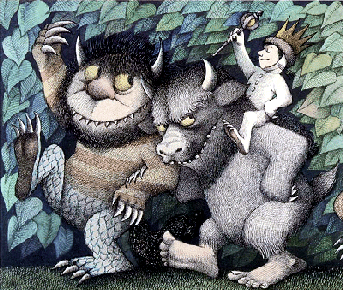
Maurice Sendak (1928-2012) was an American author and illustrator best known for his children’s book “Where the Wild Things Are.”
Sendak began his work as an artist for other authors in the 1950s before writing and drawing his own novels. He rose to prominence with his illustrations for Else Holmelund Minarik’s Little Bear book series.
In 1963, Sendak published “Where the Wild Things Are,” a children’s book that would go on to become an enduring classic. The book is noteworthy for its gorgeous illustrations and innovative writing; it tells the story of a young boy named Max who travels on an adventure to a monster kingdom.
Sendak went on to write and illustrate several more children’s books, including “In the Night Kitchen” (1970) and “Outside Over There” (1981), as well as work as a stage designer and animator.
Maurice Sendak is today regarded as one of the twentieth century’s most prominent and influential children’s book authors and illustrators. His contributions to children’s literature have influenced generations of readers and artists, and his works continue to carry on his legacy.
5. Eric Carle
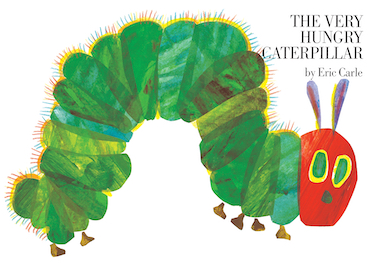
Eric Carle (1929-2021) was a popular children’s book author and artist, best known for his iconic book “The Very Hungry Caterpillar”.
Carle was born in Syracuse, New York, and raised in Germany, where he developed an interest in art and nature. As a young man, he returned to the United States and began working as a graphic designer.
Carle made his debut as a children’s book illustrator in 1967 with “The Very Hungry Caterpillar,” which has since become one of the most successful and adored children’s books of all time.
The story follows a caterpillar as it consumes several foods before converting into a beautiful butterfly. Carle’s bright drawings and simple, rhythmic writing have enthralled generations of young readers and have been translated into over 60 languages.
Carle illustrated almost 70 books over his lifetime, many of which he also wrote. His particular collage process, which entailed cutting and stacking hand-painted paper, resulted in a distinct and unmistakable look that has come to be associated with his name.
Carle’s books frequently emphasized themes of nature, animals, and the wonder of the world around us, encouraging children to explore and discover the natural world’s beauty.
Carle was an advocate for early childhood education and literacy in addition to his work as a novelist and illustrator.
At Amherst, Massachusetts, he founded the Eric Carle Museum of Picture Book Art, which honors the art of the picture book and provides educational tools for children, families, and educators. Eric Carle’s contributions to children’s literature and artistic heritage inspire and delight readers of all ages.
6. Dan Santat
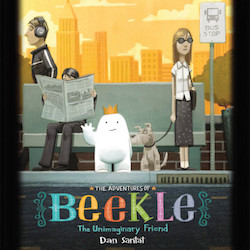
Dan Santat (born 1975) is a children’s book author and artist from the United States. He has written and illustrated numerous picture books, including the Caldecott Medal-winning “The Adventures of Beekle: The Unimaginary Friend” in 2015.
Santat grew up in California and showed an early interest in drawing. He went on to get his Bachelor of Fine Arts degree in illustration at the Art Center College of Design in Pasadena, California.
After college, Santat worked as a freelance illustrator before focusing on writing and illustrating his own children’s books. “The League of Geniuses,” his first book, was released in 2004. He has written and illustrated over 60 books for children, ranging from picture books to graphic novels, since then.
Santat’s pictures are distinguished by their brilliant colors, dynamic compositions, and inventive details. He frequently uses whimsy and comedy in his art, creating characters who are both approachable and fantastical. His stories frequently deal with topics such as friendship, inventiveness, and the force of endurance.
Santat is a mentor and champion for young artists in addition to his work as an author and illustrator. He has lectured at schools and conferences all around the world, urging young people to pursue their creative goals and follow their passions.
7. Ludwig Bemelmans
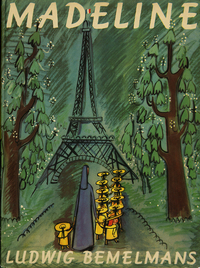
Ludwig Bemelmans (1898-1962) was an Austrian-American author and illustrator best remembered for creating the Madeline series of children’s books.
Bemelmans emigrated to the United States at the age of 16 from Merano, Austria (now Italy) and began working in the hotel industry. He had a lifelong love of art and literature, and he ultimately began selling his illustrations to journals and newspapers.
Bemelmans released the first novel in the Madeline series, which recounted the experiences of a little girl at a Parisian boarding school, in 1939. Bemelmans went on to write and draw six more Madeline stories, all of which featured the spunky heroine and her trusty pals.
The pictures of Bemelmans were noted for their unusual style, which mixed bold, black lines with vivid, primary colors. He frequently employed a method known as “crayon resists,” in which he sketched his pictures with a white crayon and then painted over them with watercolors, resulting in a unique texture and depth.
Bemelmans wrote and illustrated various novels for children and adults, including “The High World,” “The Donkey Within,” and “Life Class,” in addition to the Madeline series. As a novelist and illustrator, his legacy continues to inspire new generations of readers and artists.
8. E. H. Shepard
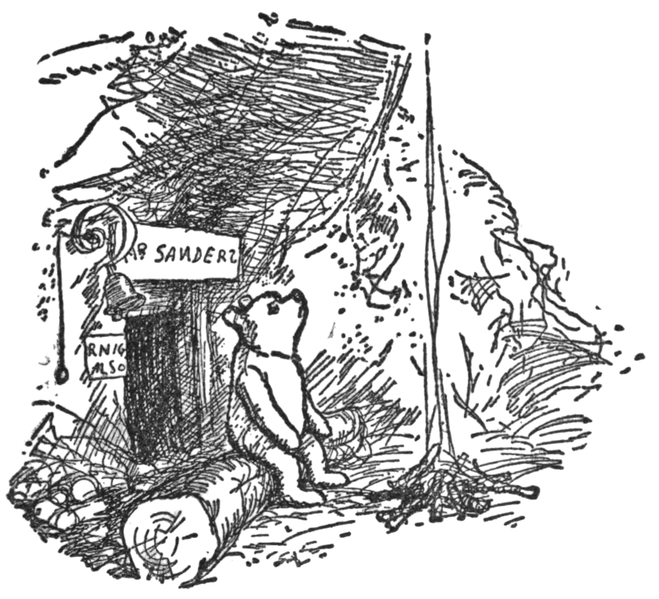
Ernest Howard Shepard (1879-1976) was an English artist and illustrator best known for his work on A. A. Milne’s “Winnie-the-Pooh” novels.
Shepard was born in London and attended the Royal Academy of Arts before beginning his career as a cartoonist and artist for newspapers and magazines. In 1924, he was commissioned to illustrate Milne’s first book, Winnie-the-Pooh, which was an instant success.
Shepard’s pictures of Winnie-the-Pooh and his buddies, especially Piglet, Tigger, Eeyore, and Christopher Robin, have become some of children’s literature’s most famous and cherished imagery. His delicate, whimsical approach caught the innocence and humor of Milne’s writings, and his characters have become iconic representations of juvenile imagination and wonder.
Shepard illustrated numerous other children’s books, including Kenneth Grahame’s “The Wind in the Willows” and J. M. Barrie’s “Peter Pan in Kensington Gardens,” in addition to the Winnie-the-Pooh novels. He was also a prolific painter, exhibiting his work in galleries across the United Kingdom.
Shepard’s impact as an illustrator and artist continues to influence future generations of artists and readers. His drawings of Winnie-the-Pooh and his buddies have become a treasured and timeless aspect of children’s literature.
9. Arthur Rackham
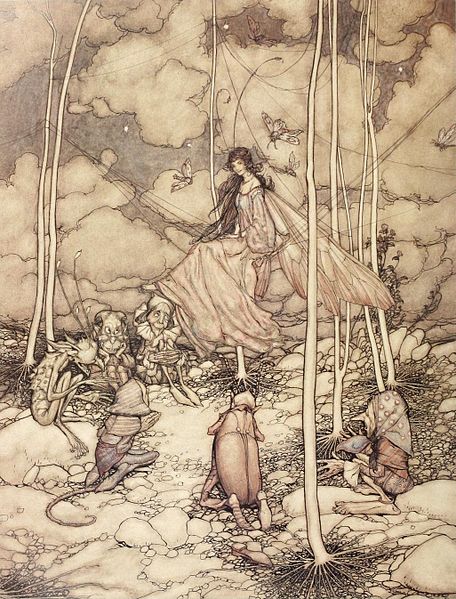
Arthur Rackham (1867-1939) was a well-known English book illustrator who was noted for his inventive and intricate pictures of fairy tales and children’s books.
Rackham, who was born in London, began his work as a clerk in an insurance company, but he soon switched to illustration. He began his career as a freelance artist for publications and books after studying at the Lambeth School of Art and later the Royal Academy.
Rackham made his name as a book illustrator with his pictures for Washington Irving’s “Rip Van Winkle” in 1905. He went on to illustrate novels by J.M. Barrie, Charles Dickens, and Edgar Allan Poe, as well as fairy tales by the Brothers Grimm and Hans Christian Andersen.
Rackham’s pictures stood out for their meticulous detail and unearthly feel. He frequently employed muted colors and delicate lines in his illustrations to produce a dreamlike feel, and he integrated mystical themes such as fairies, goblins, and legendary animals.
Rackham’s pictures were highly popular in the early twentieth century and influenced subsequent generations of illustrators and artists. His legacy as a fairy tale illustrator maestro continues to inspire future generations of readers and artists.
10. Peggy Fortnum
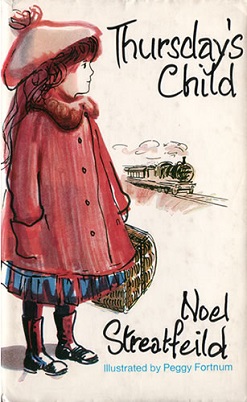
Peggy Fortnum (1919-2016) was an English illustrator best known for her illustrations of Michael Bond’s Paddington Bear series of children’s books.
Fortnum was born in London and attended the Central School of Arts and Crafts before starting her career as a freelance artist and illustrator. She was hired to draw Michael Bond’s first Paddington Bear book, which was published in 1958.
Fortnum’s pictures of Paddington Bear and his adventures in London became a hit with readers of all ages. Her intricate, appealing pictures caught the fun and spirit of Bond’s books, and her images of Paddington Bear, complete with his trademark blue coat and red hat, have become treasured childhood symbols.
Fortnum illustrated various children’s books, including “The Blue Balloon” and “The Cat Who Wanted to Go Home,” in addition to the Paddington Bear series. She also had her artwork displayed in galleries throughout England.
Fortnum’s impact as an illustrator continues to influence future generations of artists and readers. Her Paddington Bear paintings have become timeless classics that continue to amaze and enchant youngsters and adults all over the world.
11. Arnold Lobel
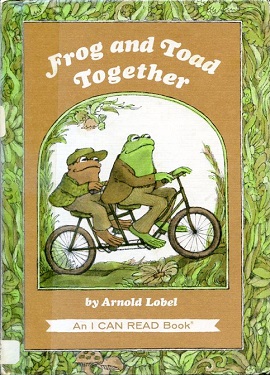
Arnold Lobel (1933-1987) was an American children’s book author and illustrator. He is most known for his stories about Frog and Toad, two charming amphibians that embark on a series of adventures together.
Lobel was born in Los Angeles, raised in Schenectady, New York, and attended art school in New York City. He began his career as a freelance illustrator before focusing on writing and illustrating his own children’s books.
The publication of “Frog and Toad Are Friends” in 1970 marked Lobel’s debut as a children’s book author and illustrator. The book, which tracked the two friends’ travels as they went on picnics, went swimming, and shared stories, was an instant success.
Lobel went on to write and illustrate three more Frog and Toad novels, as well as a slew of other children’s books.
Lobel’s pictures were well-known for their warmth, wit, and meticulous attention to detail. With his pictures, he frequently employed a soft, subdued color palette to create a soothing, peaceful ambiance, and he showed his animal figures with a strong awareness of their personalities and eccentricities.
Lobel was a teacher of illustration and a mentor to many young artists in addition to his work as an author and illustrator. As a novelist and illustrator, his legacy continues to inspire new generations of readers and artists.
12. Leo Lionni
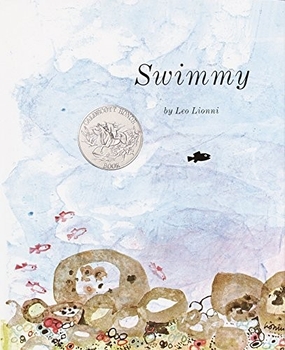
Leo Lionni (1910-1999) was an Italian-American children’s book author and illustrator. He is most recognized for his innovative stories and vivid pictures, which frequently addressed subjects such as nature, creativity, and the value of uniqueness.
Lionni was born in Amsterdam and raised in Italy before moving to the United States. He started his career as an advertisement art director before focusing on children’s book illustration and writing.
The publication of “Little Blue and Little Yellow” in 1959 marked Lionni’s debut as a children’s book author and illustrator. He created and illustrated the book, which portrayed the narrative of two colorful circles who became friends despite their differences.
Lionni went on to write and draw several additional children’s books, including “Frederick”, “Swimmy”, and “Inch by Inch”.
Lionni’s pictures were notable for their use of bright colors, basic shapes, and eye-catching compositions. He frequently employed collage techniques to make his illustrations, using different textures and materials to add depth and intrigue.
Lionni was a teacher and an advocate for arts education in addition to his work as an author and illustrator. He was a firm believer in the power of creativity to inspire and enhance the lives of children, and his books continue to do so for readers of all ages.
13. Tove Jansson
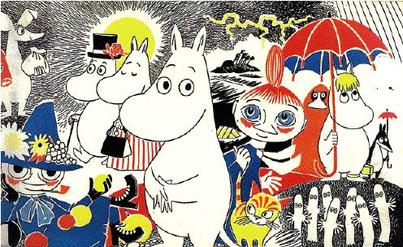
Tove Jansson (1914-2001) was a Finnish-Swedish novelist, writer, and illustrator best known for creating the Moomin series of children’s books, which have become treasured classics.
Jansson was born in Helsinki, Finland, and attended Stockholm’s University College of Arts, Crafts, and Design. She began her career as an illustrator and artist, producing political cartoons and book illustrations.
The 1945 publication of “The Moomins and the Great Flood,” Jansson’s first Moomin book, exposed the world to her charming and humorous Moomin creatures. The adventures of the Moomin family and their companions in the fictitious Moominvalley are chronicled in the nine novels and several picture books comprising the Moomin series.
Jansson’s artwork is renowned for its vivid hues, whimsical creatures, and ethereal quality. She frequently combined themes of nature, mythology, and folklore into her illustrations, lending them a timeless quality.
Jansson was not only an author and illustrator, but also a painter and a playwright. She received various awards for her literary and artistic talents, including the Hans Christian Andersen Award in 1966.
Today, readers of all ages continue to adore Tove Jansson’s Moomin books, and her legacy as a pioneering author, artist, and illustrator is honored and remembered.

